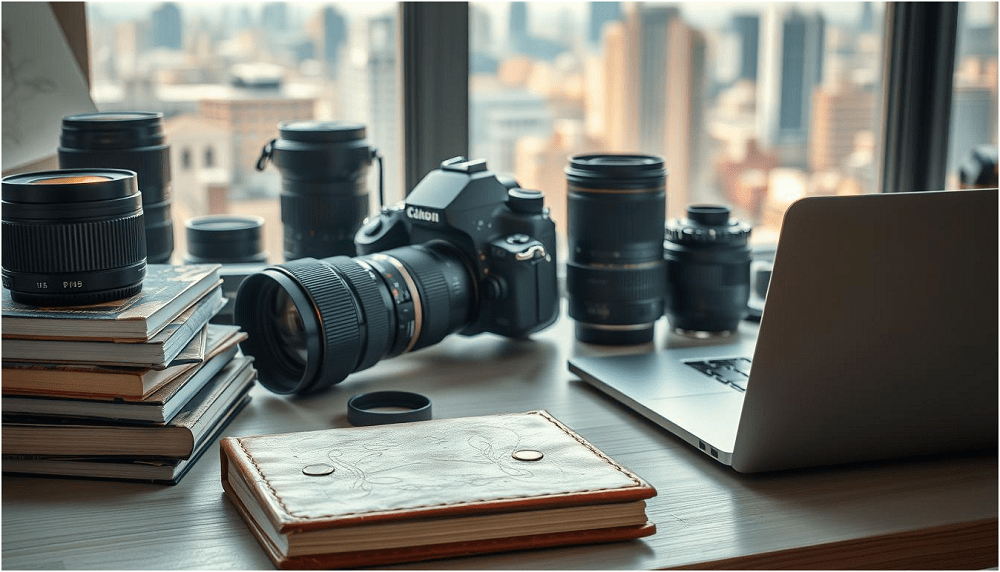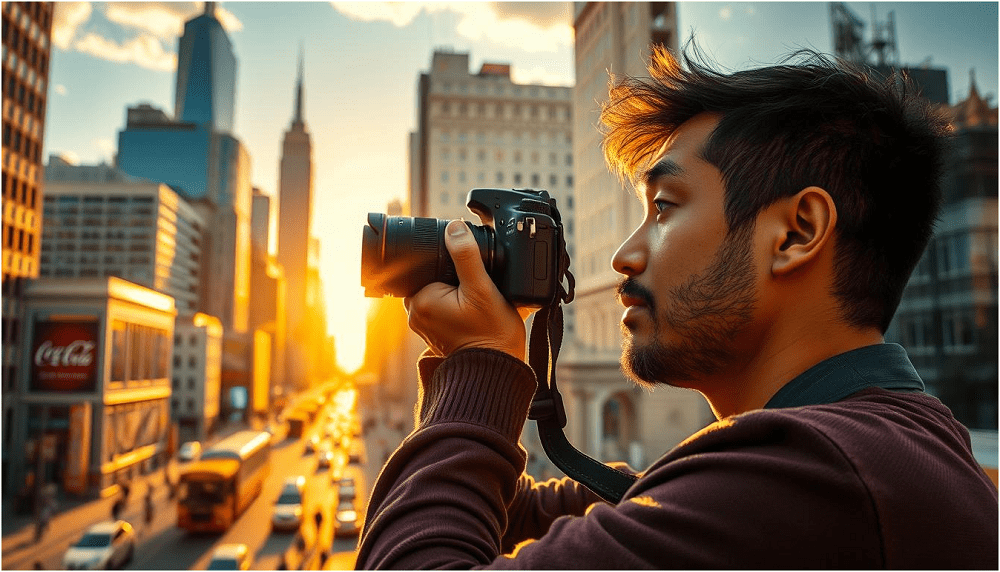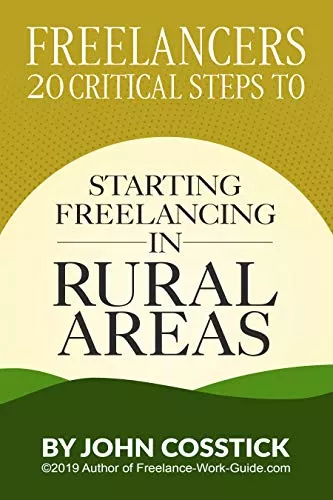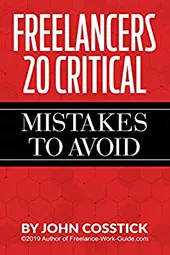Freelance photography has become a popular career path for many creative individuals. It involves capturing moments, objects, or scenes for clients without being permanently employed by a single company.

As a freelancer, photographers have the flexibility to choose their projects, work at their own pace, and build a diverse portfolio. This guide is designed to help aspiring photographers understand the basics of freelance photography and get started on their journey.
Whether you’re looking to turn your passion into a career or simply want to supplement your income, understanding the fundamentals of freelance photography is essential.
Key Takeaways
- Understanding the basics of freelance photography
- Learning how to get started as a freelance photographer
- Building a diverse portfolio
- Choosing projects and working at your own pace
- Turning your passion into a career
Definition and Core Concepts
Freelance photography is defined by the freedom to choose projects, clients, and working hours. Core concepts include understanding lighting, composition, and the ability to work with various subjects, from people to landscapes.
The role of a freelance photographer involves not just taking pictures but also editing, marketing, and managing the business side of the operation. This includes tasks like invoicing, negotiating contracts, and maintaining client relationships.
|
Key Skills |
Description |
Importance Level |
|
Technical Photography Skills |
Understanding of camera settings, lighting, and composition. |
High |
|
Business Management |
Ability to manage finances, market services, and negotiate contracts. |
High |
|
Communication Skills |
Effective interaction with clients to understand their needs and preferences. |
Medium |
How Freelance Photography Differs from Employment
Unlike employed photographers who work for a single employer, freelance photographers work on a project-by-project basis with various clients. This difference impacts income stability, work variety, and the need for self-marketing.
Freelance photographers enjoy more flexibility in their schedules and the type of projects they undertake, but they also face challenges like inconsistent income and the need to continually market themselves to attract new clients.
The Freelance Photography Landscape Today
With the rise of the photography gig economy, opportunities for freelance photographers have expanded. The industry has witnessed significant growth, driven by the increasing demand for high-quality visual content across various sectors.
Market Overview and Opportunities
The freelance photography market is characterized by a diverse range of clients and projects, from individual consumers to large corporations. This diversity creates numerous opportunities for photographers to specialize in different niches and build their personal brand. The market’s growth is further fueled by the proliferation of social media platforms, which have become essential channels for photographers to showcase their work and attract new clients.
Popular Niches in Freelance Photography
Freelance photographers can explore various niches to establish their careers. Some of the most popular areas include:
Wedding and Event Photography
Wedding and event photography remains a lucrative niche, with couples and event organizers seeking skilled photographers to capture their special moments. This niche requires a blend of technical skill, creativity, and interpersonal skills.
Commercial and Product Photography
Commercial and product photography is another significant niche, where photographers work with businesses to create high-quality images of products and services for marketing and advertising purposes. This area demands attention to detail and the ability to showcase products in an appealing manner.
Portrait and Lifestyle Photography
Portrait and lifestyle photography involves capturing the essence and personality of individuals or groups, often for personal or commercial use. This niche allows photographers to be creative and experiment with different styles and techniques.
Benefits of Becoming a Freelance Photographer
Embracing freelance photography opens up a world of creative possibilities. As a freelance photographer, you have the opportunity to explore various genres, from portrait and landscape photography to commercial and fine art photography. This diversity not only keeps your work interesting but also allows you to grow as an artist.
Creative Freedom and Flexibility
One of the most significant advantages of freelance photography is the creative freedom it offers. You have the flexibility to choose your projects, clients, and shooting schedules. This autonomy enables you to pursue photography that aligns with your passion and vision, leading to more fulfilling work.
Income Potential and Diversification
Freelance photography also presents opportunities for diversified income streams. You can offer various services such as workshops, photo editing, and stock photography, in addition to your shooting services. This diversification can lead to a more stable financial situation and increased earning potential, especially if you market your services effectively to find freelance photography jobs.
|
Service |
Description |
Potential Income |
|
Wedding Photography |
Capturing special moments on the wedding day |
$2,000 – $5,000 per event |
|
Stock Photography |
Selling stock images on platforms |
$50 – $500 per image sale |
|
Photography Workshops |
Teaching photography techniques |
$100 – $500 per participant |
Building Your Personal Brand
As a freelance photographer, you have the opportunity to build a personal brand that reflects your style and aesthetic. By consistently producing high-quality work and engaging with your audience on social media, you can establish a strong professional identity. This brand recognition is crucial for attracting clients and securing freelance photography jobs.
Challenges of Freelance Photography
As appealing as independent photography work can be, it is not immune to the challenges that come with running a business. Freelance photographers face a unique set of obstacles that can impact their career longevity and success.
Inconsistent Income and Workflow
One of the primary challenges is the inconsistency of income and workflow. Freelance photographers often experience fluctuations in client demand, leading to periods of feast or famine. This inconsistency can make financial planning and stability a significant concern.
- Unpredictable client bookings
- Variable income streams
- Difficulty in maintaining a consistent workflow
Business Management Responsibilities
Freelance photographers are not only artists but also business owners. They must manage the business aspects of their career, including marketing, accounting, and client relations. This added responsibility can be overwhelming and take away from the time available for photography.
Competition and Market Saturation
The freelance photography market is highly competitive, with many talented photographers vying for a limited number of clients. Standing out in a crowded market can be difficult, and photographers must continually adapt their strategies to remain competitive.
- High competition for clients
- Need for continuous marketing efforts
- Adapting to market trends
Essential Equipment for Freelance Photographers
The foundation of a successful freelance photography business lies in the quality and appropriateness of the equipment used. Investing in the right gear not only enhances the quality of the work but also increases efficiency and versatility across different types of photography shoots.
Camera Gear Essentials
Camera equipment is the backbone of any photography business. The right camera and lenses can significantly impact the outcome of a shoot. Looking to gear up? Check out our top picks for beginner DSLR and mirrorless cameras on Amazon by clicking HERE.
Camera Bodies and Lenses
Choosing between DSLR and mirrorless cameras depends on personal preference, budget, and specific needs. Lenses, on the other hand, are more about the type of photography one specializes in. For instance, portrait photographers often prefer prime lenses for their superior quality and shallow depth of field.
Lighting Equipment
Lighting can make or break a photograph. Freelance photographers need to be adept at handling various lighting conditions, from natural light to studio strobes. Investing in a good external flash and light modifiers can greatly enhance the quality of indoor and outdoor shoots. Check the best sellers in lighting equipment on Amazon by clicking HERE.
Software and Digital Tools
In today’s digital age, post-processing is an integral part of photography. Software like Adobe Lightroom and Photoshop are indispensable for editing and enhancing images. Moreover, having a reliable computer with sufficient storage and processing power is crucial for handling large image files. Here is some photo and video editing software from Amazon:
Studio vs. On-Location Equipment Considerations
The decision to invest in studio equipment or gear suitable for on-location shoots depends on the type of photography services offered. Studio photographers need a controlled environment with appropriate backdrops, lighting, and props, while on-location photographers require portable and versatile equipment that can adapt to different environments.
Building Your Photography Skills and Style
To stand out in the competitive world of freelance photography, honing your skills and style is essential. As a freelance photographer, your ability to capture compelling images depends on your technical proficiency and your unique visual perspective.
Technical Skills Development
Technical skills are the foundation upon which great photography is built. This includes understanding your camera’s capabilities, mastering lighting techniques, and being proficient in photo editing software.
- Understand your camera’s settings and capabilities
- Practice different lighting setups and techniques
- Familiarize yourself with photo editing software like Adobe Lightroom and Photoshop
Finding Your Unique Style
Your photography style is what sets you apart from others. It’s a reflection of your vision and creativity. To develop your style, experiment with different genres, such as portrait, landscape, or street photography.

Continuous Learning Resources
The photography world is constantly evolving, with new techniques and technologies emerging regularly. To stay ahead, it’s crucial to continuously learn and improve.
- Online tutorials and workshops
- Photography books and magazines
- Participating in photography communities and forums
By focusing on technical skills development, finding your unique style, and leveraging continuous learning resources, you can significantly enhance your freelance photography career.
Creating a Stunning Photography Portfolio
In the competitive world of freelance photography, a strong portfolio can be the key to standing out and securing new opportunities. A well-crafted portfolio not only showcases your technical skills but also tells a story about your style and approach to photography.
Portfolio Website Best Practices
Having a professional portfolio website is crucial for freelance photographers. It serves as a central hub where potential clients can view your work, learn about your services, and get in touch. When building your portfolio website, ensure that it is visually appealing, easy to navigate, and optimized for various devices. Use clear categories and concise descriptions to help visitors quickly understand your work.
Showcasing Your Best Work Strategically
When it comes to showcasing your photography work, strategy is key. You need to present your images in a way that captures the viewer’s attention and communicates your unique vision.
Organizing by Project or Theme
Organizing your portfolio by project or theme helps to tell a cohesive story and demonstrates your ability to handle different types of photography assignments. This approach also makes it easier for potential clients to find relevant work.
Quality Over Quantity
It’s more important to showcase a smaller selection of high-quality images than to overwhelm your portfolio with a large number of mediocre photos. Quality images reflect positively on your professionalism and skill level.
Telling Visual Stories
Your portfolio should not just be a collection of images; it should tell a story about your photographic journey and style. Use your images to convey emotion, mood, and narrative, making your portfolio memorable and impactful.
Finding Freelance Photography Jobs
The photography gig economy is thriving, and learning how to navigate it can significantly boost your freelance career. As a freelance photographer, you have multiple avenues to explore for finding jobs.
Online Platforms for Photographers
Online platforms are a crucial starting point for many freelance photographers. Websites like SmugMug, 500px, and Shutterstock allow you to showcase your work and connect with potential clients. Additionally, platforms like Upwork and Freelancer offer a range of photography gigs.
To maximize your visibility on these platforms, ensure your profile is complete, and your portfolio is up-to-date. Engage with the community by participating in discussions and sharing your work.
Local Marketing Strategies
Local marketing is another effective way to find freelance photography jobs. Utilize social media platforms like Instagram and Facebook to promote your work and engage with your local community. Attend local events, workshops, and conferences to network with potential clients and other photographers.
Consider partnering with local businesses to offer your services. For example, you could collaborate with a local boutique to provide product photography or work with a real estate agent to photograph properties.
Building a Referral Network
Building a strong referral network is vital for sustaining a successful freelance photography career. Encourage satisfied clients to refer you to their friends and family by offering incentives such as discounts on future shoots.
Maintain a strong relationship with your clients through regular communication and excellent customer service. This will not only lead to repeat business but also positive word-of-mouth, which is a powerful marketing tool.
|
Platform |
Description |
Benefits |
|
SmugMug |
A platform to showcase and sell your photography work. |
Customizable portfolios, e-commerce integration. |
|
500px |
A community-driven platform for photographers. |
Exposure to a large community, licensing opportunities. |
|
Upwork |
A freelance marketplace that includes photography gigs. |
Variety of job postings, secure payment processing. |
Setting Your Rates and Managing Finances
To thrive in the competitive world of freelance photography, photographers must balance their creative passion with sound financial planning. This involves setting appropriate rates, drafting comprehensive contracts, and understanding tax obligations.
Pricing Strategies for Different Photography Services
Freelance photographers offer a variety of services, from portrait and event photography to commercial and fine art photography. Each service requires a different pricing strategy. For instance, event photography might be priced per hour or per event, while commercial photography could be priced based on the usage rights of the images.
- Research competitors and market rates
- Consider the cost of equipment and time
- Factor in travel and other expenses
Contracts and Client Agreements
A well-drafted contract protects both the photographer and the client by clearly outlining the terms of the agreement. This includes the scope of work, payment terms, and copyright information.
Key elements of a photography contract include:
- Clear description of services to be provided
- Payment schedules and amounts
- Copyright and usage rights
Tax Considerations for Freelancers
Freelance photographers are considered self-employed and must report their income and expenses on their tax return. Understanding deductions for business expenses, such as equipment and travel costs, can help reduce taxable income.
By carefully managing these financial aspects, freelance photographers can focus on their craft and build a successful, sustainable business in the competitive world of independent photography work.
Conclusion: Your Path to Freelance Photography Success
Embarking on a career as a freelance photographer requires a blend of technical skill, creative vision, and business acumen. By understanding the fundamentals of freelance photography, including how to become a freelance photographer, you can set the stage for a successful and fulfilling career. Key to this journey is developing your photography skills, creating a stunning portfolio, and effectively marketing your services to potential clients.
Setting appropriate freelance photography rates is crucial for sustaining a profitable business. It involves understanding your costs, researching the market, and considering the value you bring to clients. As you progress, continually refining your pricing strategy and business practices will be essential.
With persistence, dedication, and a willingness to learn and adapt, you can navigate the challenges of freelance photography and achieve success. Take the first step today by applying the insights and strategies outlined in this guide, and start building the freelance photography career you’ve always envisioned.
FAQ
Q1: What is freelance photography?
Freelance photography refers to the practice of photographers working on a project-by-project basis, often for various clients, without being permanently employed by a single company or organization. Freelance photographers manage their own businesses, handling everything from marketing to financial management.
Q2: How do I become a freelance photographer?
To become a freelance photographer, you typically need to develop your photography skills, build a portfolio, and learn about the business aspects of freelancing, such as marketing, pricing, and contracts. Understanding your niche and target market is also crucial.
Q3: What are the benefits of freelance photography?
The benefits of freelance photography include creative freedom, the ability to choose projects and clients, flexibility in scheduling, and the potential for higher earnings based on your skill level and the demand for your services.
Q4: How do I find freelance photography jobs?
Freelance photography jobs can be found through various channels, including online platforms like Upwork or Freelancer, local marketing efforts such as networking events or social media, and by building a strong referral network among past clients and other professionals.
Q5: What equipment do I need to start freelance photography?
The essential equipment for freelance photography includes a good camera body, appropriate lenses, lighting equipment, and software for editing photos. The specific gear needed can vary depending on the type of photography you specialize in, such as wedding, commercial, or portrait photography.
Q6: How do I set my rates as a freelance photographer?
Setting rates as a freelance photographer involves considering factors like your experience, the type of photography service, the location, and the client’s budget. Researching what other photographers in your niche are charging can also help you determine competitive pricing.
Q7: What are the challenges of freelance photography?
Challenges faced by freelance photographers include managing inconsistent income and workflow, handling business management tasks, dealing with competition, and continually marketing themselves to attract new clients.
Q8: How do I manage finances as a freelance photographer?
Managing finances as a freelance photographer involves setting appropriate rates, creating and managing contracts, tracking expenses, and understanding tax obligations. It’s also important to plan for periods of low income and to save for taxes and business expenses.
Q9: Can I specialize in multiple types of photography as a freelancer?
Yes, many freelance photographers choose to specialize in multiple types of photography to diversify their income streams and keep their work interesting. However, it’s also important to establish a strong brand and focus in at least one area to attract a loyal client base.















